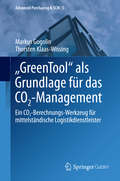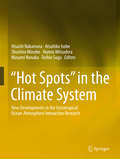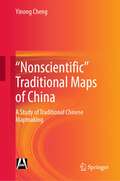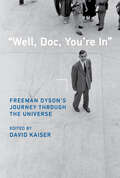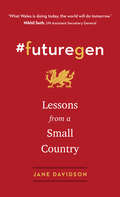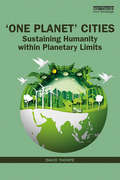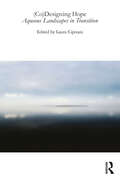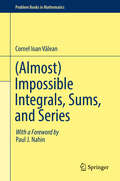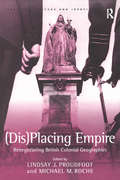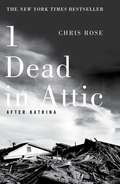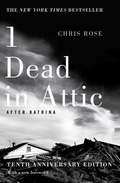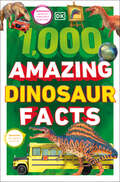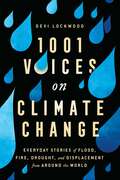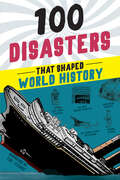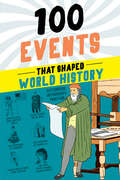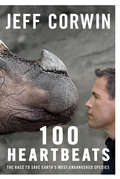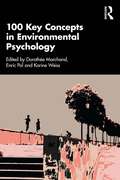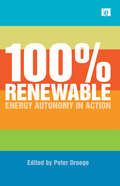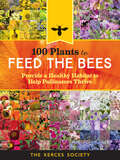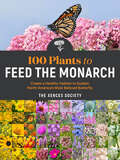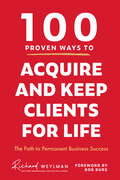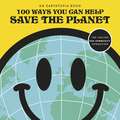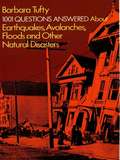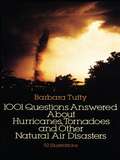- Table View
- List View
"GreenTool" als Grundlage für das CO2-Management: Ein CO2-Berechnungs-Werkzeug für mittelständische Logistikdienstleister (Advanced Purchasing & SCM #5)
by Thorsten Klaas-Wissing Markus GogolinWeltweit verursachen Transport und Verkehr etwa ein Drittel der CO2-Emissionen, davon entfallen 75 Prozent auf den Straßenverkehr. NGOs, der Gesetzgeber aber auch Verlader fordern daher zunehmend Transparenz und die Senkung von CO2-Emissionen, was dazu geführt hat, dass sich CO2-Management für Logistikdienstleister zu einem strategischen Zukunftsthema entwickelt hat. Führende Logistikdienstleister setzen sich mit dem Thema CO2-Management intensiv auseinander und haben zur Erfassung und zum Reporting von Emissionskennzahlen weitgehend unternehmensindividuelle Lösungsansätze erarbeitet. Insbesondere mittelständische Logistikdienstleister stehen aber vor der Herausforderung, trotz schlanker Geschäftsstrukturen und begrenzter finanzieller sowie personeller Ressourcen, kontinuierlich Wissen aufzubauen und ein geeignetes operatives Instrumentarium für das CO2-Management zu entwickeln.
"Hot Spots" in the Climate System: New Developments in the Extratropical Ocean-Atmosphere Interaction Research
by Hisashi Nakamura Atsuhiko Isobe Shoshiro Minobe Humio Mitsudera Masami Nonaka Toshio SugaThis book consists of the articles from thespecial issue of "'Hot Spots' in the Climate System" in the Journal of Oceanography,Vol. 71 No. 5, 2015, comprising 9 chapters that cover a wide spectrum oftopics. This spinoff book is a collection of papers on the scientific outcomesof a nationwide 5-year project funded by the Japanese Ministry of Education,Culture, Sports, Science and Technology (MEXT) and known internationally as the"Hot-Spot Project. " The academic achievement of the project has gainedinternational recognition, making substantial contribution to unveiling theclimatic role of warm western boundary ocean currents, including the Kuroshio,and associated oceanic fronts characterized by sharp temperature gradients andactive meso-scale oceanic eddies. Specifically, those warm currents may becalled "hot spots" in the climate system, as they intensively release heat andmoisture to the atmosphere, thereby acting to organize clouds and precipitationsystems and set conditions favorable for recurrent development of storms. Thisspinoff is a unique collection of the outcome of the particular project. Thecollected papers cover a wide range of aspects of ocean-atmosphere interactioncharacteristic of the oceanic fronts and continental marginal seas, unveiledthrough observational, theoretical, analytical, and numerical investigations. Most of the readers of the book are assumed to be researchers and graduatestudents who study climate dynamics, physical oceanography, atmosphericscience, and air-sea interaction.
"Nonscientific” Traditional Maps of China: A Study of Traditional Chinese Mapmaking
by Yinong ChengThis book analyzes the drawing data and methods of the Chinese ancient maps that are neglected by the previous researches, and reevaluates the drawing theories and methods, the influences, and accuracy of the maps that represents the scientificity of Chinese ancient cartographic drawings.
"Well, Doc, You're In": Freeman Dyson’s Journey through the Universe
by Edited by David KaiserThe life and work of Freeman Dyson—renowned scientist, visionary, and iconoclast—and his particular way of thinking about deep questions.Freeman Dyson (1923–2020)—renowned scientist, visionary, and iconoclast—helped invent modern physics. Not bound by disciplinary divisions, he went on to explore foundational topics in mathematics, astrophysics, and the origin of life. General readers were introduced to Dyson&’s roving mind and heterodox approach in his 1979 book Disturbing the Universe, a poignant autobiographical reflection on life and science. &“Well, Doc, You&’re In&” (the title quotes Richard Feynman&’s remark to Dyson at a physics conference) offers a fresh examination of Dyson&’s life and work, exploring his particular way of thinking about deep questions that range from the nature of matter to the ultimate fate of the universe. The chapters—written by leading scientists, historians, and science journalists, including some of Dyson&’s colleagues—trace Dyson&’s formative years, his budding interests and curiosities, and his wide-ranging work across the natural sciences, technology, and public policy. They describe Dyson&’s innovations at the intersection of quantum theory and relativity, his novel nuclear reactor design (and his never-realized idea of a spacecraft powered by nuclear weapons), his years at the Institute for Advanced Study, and his foray into cosmology. In the coda, Dyson&’s daughter Esther reflects on growing up in the Dyson household. &“Well, Doc, You&’re In&” assesses Dyson&’s successes, blind spots, and influence, assembling a portrait of a scientist&’s outsized legacy. ContributorsJeremy Bernstein, Robbert Dijkgraaf, Esther Dyson, George Dyson, Ann Finkbeiner, Amanda Gefter, Ashutosh Jogalekar, David Kaiser, Caleb Scharf, William Thomas
#futuregen: Lessons from a Small Country
by Jane Davidson"What Wales is doing today, the world will do tomorrow.”—Nikhil Seth, UN Assistant Secretary General <P><P> The story of how one small nation responded to global climate issues by radically rethinking public policy for future generations <P><P> In #futuregen, Jane Davidson explains how, as Minister for Environment, Sustainability and Housing in Wales, she proposed the Well-being of Future Generations (Wales) Act 2015—the first piece of legislation on Earth to place regenerative and sustainable practice at the heart of government. Unparalleled in its scope and vision, the Act connects environmental and social health and looks to solve complex issues such as poverty, education and unemployment. <P><P> Davidson reveals how and why such groundbreaking legislation was forged in Wales—once reliant on its coal, iron and steel industries—and explores how the shift from economic growth to sustainable growth is creating new opportunities for communities and governments all over the world. <P><P> #futuregen is the inspiring story of a small, pioneering nation discovering prosperity through its vast natural beauty, renewable energy resources and resilient communities. It’s a living, breathing prototype for local and global leaders as proof of what is possible in the fight for a sustainable future.
#futuregen: Lessons from a Small Country
by Jane Davidson"What Wales is doing today, the world will do tomorrow.&”—Nikhil Seth, UN Assistant Secretary General The story of how one small nation responded to global climate issues by radically rethinking public policy for future generations In #futuregen, Jane Davidson explains how, as Minister for Environment, Sustainability and Housing in Wales, she proposed the Well-being of Future Generations (Wales) Act 2015—the first piece of legislation on Earth to place regenerative and sustainable practice at the heart of government. Unparalleled in its scope and vision, the Act connects environmental and social health and looks to solve complex issues such as poverty, education and unemployment. Davidson reveals how and why such groundbreaking legislation was forged in Wales—once reliant on its coal, iron and steel industries—and explores how the shift from economic growth to sustainable growth is creating new opportunities for communities and governments all over the world. #futuregen is the inspiring story of a small, pioneering nation discovering prosperity through its vast natural beauty, renewable energy resources and resilient communities. It&’s a living, breathing prototype for local and global leaders as proof of what is possible in the fight for a sustainable future.
'One Planet' Cities: Sustaining Humanity within Planetary Limits
by David ThorpeThis book addresses the crucial question of how the essential needs of the growing human population can be met without breaking the Earth's already-stretched life-support system. With four out of five people predicted to be urban dwellers by 2080, ‘One Planet’ Cities proposes a pathway to genuine sustainability for cities and neighbourhoods, using an approach based on contraction and convergence. Utilising interviews with key players, including the Global Footprint Network, World Future Council, WWF, mayors and government officials, and case studies from across the globe, including Europe, North and South America, Australia, South Africa, China and India, David Thorpe examines all aspects of modern society from food provision to neighbourhood design, via industry, the circular economy, energy and transport through the critical lens of the ecological footprint and relevant supporting international standards and indicators. Recommendations on managing supply chains and impacts, how the transition to a world within limits might be financed, and a deep examination of the Welsh Government's pioneering efforts follow. It concludes with an imagined vision of what a genuinely sustainable future might be like, and an appeal for 'one planeteers' everywhere to step up to the challenge. This book will be of great interest to practitioners and policymakers involved in governance, administration, urban environments and sustainability, alongside students of the built environment, urban planning, environmental policy and energy.
(Co)Designing Hope: Aqueous Landscapes in Transition
by Laura CiprianiExtreme weather events, droughts, floods, shifts in precipitation and temperature patterns, melting glaciers, sea-level rise, water salinization, and more generally, changes in the water cycle remind us that the climate crisis is mostly a water crisis. Perhaps even more serious is a crisis of imagination connected with thought and with creative, far-sighted action able to combine the visionary and the pragmatic. A response to these two crises can be provided by the disciplines of landscape architecture: these have always featured a plural, collective approach that comprises or originates from living systems and natural forces, on the involvement of human and nonhuman communities in the design process, and the inclusion of the time variable in future plans—without neglecting the necessary flexibility of creative and pragmatic thinking. How can landscape design and different forms of collaboration open new doors to face climate and water challenges? What hopes can spring from collective design in its broader meaning?This book sets out notions and ideas on water landscapes and (co)designed practices, identifying what hopeful routes might be taken for the three states of aqueous landscapes in transition—liquid, solid, and gas. The chapters show different scales and levels of design and collaborative practices: from large and governmental projects to small bottom-up interventions; from creative collaboration among designers to traditional community design; from participatory processes to nature as a co-designer for tackling the climate crisis. People, animals, plants, water, ice, fog, clouds, wind, sand, and rocks—all contribute to the cosmos’ landscape symphony, and designing together can become a seed of hope to listen and embrace the Earth’s climate changes.
**Missing** (Problem Books in Mathematics)
by Cornel Ioan VăleanThis book contains a multitude of challenging problems and solutions that are not commonly found in classical textbooks. One goal of the book is to present these fascinating mathematical problems in a new and engaging way and illustrate the connections between integrals, sums, and series, many of which involve zeta functions, harmonic series, polylogarithms, and various other special functions and constants. Throughout the book, the reader will find both classical and new problems, with numerous original problems and solutions coming from the personal research of the author. Where classical problems are concerned, such as those given in Olympiads or proposed by famous mathematicians like Ramanujan, the author has come up with new, surprising or unconventional ways of obtaining the desired results. The book begins with a lively foreword by renowned author Paul Nahin and is accessible to those with a good knowledge of calculus from undergraduate students to researchers, and will appeal to all mathematical puzzlers who love a good integral or series.
**Missing**: Renegotiating British Colonial Geographies (Heritage, Culture and Identity)
by Michael M. RocheWhile there has been for the past two decades a lively and extensive academic debate about postcolonial representations of imperialism and colonialism, there has been little work which focuses on 'placed' materialist or critical geographical perspectives. The contributors to this volume offer such a perspective, asserting the inadequacy of conventional 'self/other' binaries in postcolonial analysis which fail to recognise the complex ways in which space and place were implicated in constructing the individual experience of Empire. Illustrated with case studies of British colonialism in Australia, Hong Kong, India, Ireland and New Zealand in the later nineteenth and twentieth centuries, the book uncovers the complex and unstable spaces of meaning which were central to the experience of emigrants, settlers, expatriates and indigenous peoples at different time/place moments under British rule. In critically examining place and hybridity within a discursive context, (Dis)placing Empire offers new insights into the practice of Empire.
1 Dead in Attic: After Katrina
by Chris RoseChris Rose is a columnist for The Times-Picayune in New Orleans,an essayist for The News Hour with Jim Lehrer,and a frequent commentator for National Public Radio's Morning Edition. In 2006, he was a finalist for the Pulitzer Prize for Distinguished Commentary in recognition of his Katrina columns and was awarded a share in the Times-Picayune staff's Pulitzer for Public Service. Rose lives in New Orleans with his three children.
1 Dead in Attic: After Katrina
by Chris RoseWith a new foreword by the author—Chris Rose&’s New York Times bestselling collection: &“A gripping book about life&’s challenges in post-Katrina New Orleans…packed with heart, honesty, and wit&” (New Republic).Celebrated as a local classic and heaped with national praise, 1 Dead in Attic is a brilliant collection of columns by an award-winning Times-Picayune journalist chronicling the horrific damage and aftermath wrought by Hurricane Katrina in 2006. “Frank and compelling...vivid and invaluable” (Booklist), it is a roller coaster ride through a devastated American wasteland as it groans for rebirth. Full of the emotion, tragedy and even humor—which has made Chris Rose a favorite son and the voice of a lost city—these are the stories of the dead and the living, of survivors and believers, of destruction and recovery, and of hope and despair. With photographs by British photojournalist Charlie Varley, 1 Dead in Attic captures New Orleans caught between an old era and a new, New Orleans in its most desperate time, as it struggled out of floodwaters and willed itself back to life.
1,000 Amazing Dinosaurs Facts: Unbelievable Facts About Dinosaurs
by DKAstonish your friends and family with this incredible collection of mind-boggling facts about the scariest animals ever to walk the Earth. This unbelievably fascinating dinosaur book for children will teach you all you need to know about prehistoric animals, like which dinosaur had the sharpest teeth, the longest claws, the smallest brain, the largest droppings, and lots more! Did you know that the largest dinosaur was longer than a tennis court but its babies were no bigger than a newborn human baby? That the smallest dinosaur weighed less than a teaspoon of sugar? Or that the largest flying reptile was as tall as a giraffe, with wings the size of a small plane? Children aged 9+ will love all these facts and more, presented either with jaw-dropping CGI illustrations or eye-popping photography – plus additional boxes feature diagrams that make information easy to understand. Celebrate your child's curiosity as they explore:- 1,000 jaw-dropping, mind-blowing facts that will be sure to wow family and friends. - Stunning CGI graphics, fun visual comparisons, and diagrams make stats and facts easy to understand.- Science boxes are illustrated with engaging diagrams.- Photo stories feature additional incredible stories and comparisons.In 1,000 Amazing Dinosaur Facts children can discover the fastest, the slowest, the deadliest, and the downright weirdest dinosaurs ever to roam the planet! This book of mind-blowing dinosaur facts will make the ideal gift for kids who love all things prehistoric, giving a real sense of the colossal scale of dinosaurs and how and where they lived.More in the SeriesIf you like 1,000 Amazing Dinosaur Facts then why not complete the collection? Dive into disgusting facts with 1,000 Amazing Gross Facts and discover the secret science of everything icky and sticky.
1,001 Voices on Climate Change: Everyday Stories of Flood, Fire, Drought, and Displacement from Around the World
by Devi LockwoodJoin journalist Devi Lockwood as she bikes around the world collecting personal stories about how flood, fire, drought, and rising seas are changing communities. It&’s official: 2020 will be remembered as the year when apocalyptic climate predictions finally came true. Catastrophic wildfires, relentless hurricanes, melting permafrost, and coastal flooding have given us a taste of what some communities have already been living with for far too long. Yet we don&’t often hear the voices of the people most affected. Journalist Devi Lockwood set out to change that. In 1,001 Voices on Climate Change, Lockwood travels the world, often by bicycle, collecting first-person accounts of climate change. She frequently carried with her a simple cardboard sign reading, &“Tell me a story about climate change.&” Over five years, covering twenty countries across six continents, Lockwood hears from indigenous elders and youth in Fiji and Tuvalu about drought and disappearing coastlines, attends the UN climate conference in Morocco, and bikes the length of New Zealand and Australia, interviewing the people she meets about retreating glaciers, contaminated rivers, and wildfires. She rides through Thailand, Laos, and Cambodia to listen to marionette puppeteers and novice Buddhist monks. From Denmark and Sweden to China, Turkey, the Canadian Arctic, and the Peruvian Amazon, she finds that ordinary people sharing their stories does far more to advance understanding and empathy than even the most alarming statistics and studies. This book is a hopeful global listening tour for climate change, channeling the urgency of those who have already glimpsed the future to help us avoid the worst.
100 Disasters That Shaped World History (100 Series)
by Joanne MatternAction-packed true stories of the biggest disasters in history - perfect for fans of the I Survived seriesDiscover how hurricanes, earthquakes, crashes, and other catastrophes have shaped world history! 100 Disasters That Shaped World History introduces kids of all ages to some of the most significant events in recorded history, from the Great Fire of London to the Challenger Disaster. This history book for kids features100 easy-to-read true disaster stories: Find out how catastrophes have changed the course of history!Illustrated images: Each page includes an illustration to help bring history to life!A timeline, trivia questions, project ideas, and more: Boost your learning and test your knowledge with fun activities and resources!Engaging and packed with facts, 100 Disasters That Shaped World History is the perfect history gift for curious kids 8 and up!
100 Events That Shaped World History (100 Series)
by Bill YenneDiscover the fascinating stories behind the most important events of all time in this history book for kids 8 and up!From the founding of Rome to people walking on the moon, 100 Events That Shaped World History introduces kids to the greatest discoveries, most important battles, and most pivotal movements that changed the course of human history. This history book for kids features:100 easy-to-read stories of important moments in history: Find out how the modern world came to be!Illustrated images: Each page includes an illustration to help bring history to life!A timeline, trivia questions, project ideas, and more: Boost your learning and test your knowledge with fun activities and resources!Engaging and packed with facts, this book is the perfect classroom resource or history gift for curious kids!
100 Heartbeats: The Race to Save Earth's Most Endangered Species
by Jeff CorwinIt's no secret that our planet—and the delicate web of ecosystems that comprise it—is in crisis. Environmental threats such as climate change, pollution, habitat loss, and land degradation threaten the survival of thousands of plant and animal species each day. In 100 Heartbeats, conservationist and television host Jeff Corwin provides an urgent, palpable portrait of the wildlife that is suffering in silence and teetering on the brink of extinction. From the forests slipping away beneath the stealthy paws of the Florida panther, to the giant panda's plight to climb ever higher in the mountains of China in search of sustenance, to the brutal poaching tactics that have devastated Africa's rhinoceros and elephant populations, Corwin takes readers on a global tour to witness firsthand the critical state of our natural world. Along the way, he shares inspiring stories of battles being waged and won in defense of the earth's most threatened creatures by the conservationists on the front lines. These stories of hope and progress underscore an important message: Our own survival, as well as that of the world's wildlife, is in our hands. The race to save the planet's most endangered wildlife is under way. Every heartbeat matters.
100 Key Concepts in Environmental Psychology
by Dorothée MarchandThis accessible book defines 100 key concepts, ideas and processes in Environmental Psychology to provide an introductory reference work that brings together research and theory in a bite-size format. With contributions from leading figures within Environmental Psychology, each concept is clearly defined and explained within the context of issues around the environment, sustainability, climate change, nature and architecture. This book considers the involvement of psychological, physiological and social processes to understand the mechanisms that explain and contribute to the evolution of behavior and attitudes that relate to our relationship with the environment. Concepts covered include biodiversity, eco-anxiety, place identity, sustainable behaviour, climate justice and environmental attitudes. By integrating ideas from different disciplinary orientations in the field of Environmental Psychology, this book allows for a better understanding of the processes related to the individual-environment relationship, as well as the applications that they allow for in various fields of intervention. This is essential reading for students and researchers in Environmental Psychology, Sustainability Studies, Architecture and Built Environment Studies and related fields.
100 Per Cent Renewable: Energy Autonomy in Action
by Peter DroegeThe greatest challenge of our time is to build a world based on the sustainable use of renewable power. Our massive dependence on fossil fuels has upset the very climatic system that made human evolution possible. The global economy and its financial system are in jeopardy, running hot on overtly cheap yet increasingly costly and fast depleting oil. A 100% renewable world is seen by many as an impossible dream in anything but the very long term. But not only do a growing number of initiatives and plans dare to make the change but many have already achieved it. This rich collection presents a series of pioneering efforts and their champions, and the paths to their successes. Ranging from initiatives by individuals to visions for companies, communities and entire countries, it defeats tired economic and technical counter-arguments, showing how the schemes featured not only can and do work but do so economically and with available technology. The book is introduced by incisive writing by Peter Droege, explaining the challenges and framing a roadmap towards a 100% renewable reality.
100 Plants to Feed the Bees: Provide a Healthy Habitat to Help Pollinators Thrive
by The Xerces SocietyThe international bee crisis is threatening our global food supply, but this user-friendly field guide shows what you can do to help protect our pollinators. The Xerces Society for Invertebrate Conservation offers browsable profiles of 100 common flowers, herbs, shrubs, and trees that support bees, butterflies, moths, and hummingbirds. The recommendations are simple: pick the right plants for pollinators, protect them from pesticides, and provide abundant blooms throughout the growing season by mixing perennials with herbs and annuals! 100 Plants to Feed the Bees will empower homeowners, landscapers, apartment dwellers — anyone with a scrap of yard or a window box — to protect our pollinators.
100 Plants to Feed the Monarch: Create a Healthy Habitat to Sustain North America's Most Beloved Butterfly
by The Xerces SocietyThe plight of the monarch butterfly has captured public attention and sparked widespread interest in helping to save their dwindling populations. In this in-depth portrait of the monarch butterfly—covering its life cycle, its remarkable relationship with milkweed, its extraordinary migration, and the threats it now faces due to habitat loss and climate change—detailed instructions on how to design and create monarch-friendly landscapes are enriched by guidance on observing and understanding butterfly behavior and habits. Following the model of their previous best-selling book, 100 Plants to Feed the Bees, the Xerces Society provides at-a-glance profiles of the plant species that provide monarchs with nourishment. The plants, which are all commercially available, range from dozens of species of milkweed—the only food of monarch caterpillars—to numerous flowering plants, shrubs, and trees that provide nectar for the adult butterfly, including those that bloom in late season and sustain monarchs in their great migration. Gorgeous photographs of monarchs and plants, plus illustrations, maps, and garden plans, make this a visually engaging guide.
100 Proven Ways to Acquire and Keep Clients for Life: The Path to Permanent Business Success
by C. Richard WeylanUnderstand the Keys to Client Acquisition and Lasting RelationshipsMaking powerful connections with a prospective client, so they engage and stay with you is increasingly difficult. C. Richard Weylman’s proven path to cultivating client relationships is essential for success.Elevate your client’s experience and win more business. This is the first book to detail how professionals can acquire more clients and establish their lasting loyalty through the experience they provide. Many books are written on acquisition strategies, better customer service or an elevated experience. But none gives the reader the step-by-step tactical strategies to make both acquisition and loyalty happen in concert like this book does. It is the permanent business growth and success handbook for 21st century professionals in sales, marketing, and service.Give your clients the appreciation that they deserve. Working with a company can be stressful for many clients, especially if they feel they are not being heard. 100 Proven Ways to Acquire and Keep Clients for Life reveals effective methods for providing your sincerest attention to your client base. Each chapter examines the best ways to utilize empathy, thoughtfulness, and assurance in delivering an exceptional client experience. That way, both you and your client are advocating for each other’s long-term success.Inside find genuine insight and key tips on creating and managing client relationships such as:What buyers of every product or service actually want and why it mattersThe critical link between client acquisition and long-term loyaltyThe proven path to engage with people to become the provider of choiceHow to create rock-solid relationships that withstand competitive pressureIf you liked business books such as Unreasonable Hospitality, The Power of Why, or Change, you’ll love C. Richard Weylman’s 100 Proven Ways to Acquire and Keep Clients for Life.
100 Ways You Can Help Save The Planet: Packed to the brim with tips on saving the planet in easy and accessible ways
by EarthtopiaPopular climate change TikTok sensation, Earthtopia, brings a book packed to the brim with tips on saving the planet in easy and accessible ways.Want to save the planet? Start here.Earthtopia is here to teach you the little things you can do that make a huge difference to our planet.Things like:- Ditching fast fashion- Making your school plastic-free- Learning to fix your belongings- Using reef safe sunscreen- Getting involved in political change- And . . . bamboo-ing your poo?!With these and 100 other tips that make a massive impact, Earthtopia is here to help you live your best life - without costing the earth.
1001 Questions Answered About: Earthquakes, Avalanches, Floods and Other Natural Disasters
by Barbara TuftyThis highly readable and informative guide answers hundreds of fascinating questions about storms and atmospheric phenomena. In addition to dispelling common misconceptions, it imparts a wealth of solid scientific data about hurricanes, tornadoes, thunderstorms, wind, fog, ice storms, and other events. The text is embellished with 72 drawings and 20 photographs.
1001 Questions Answered About: Hurricanes, Tornadoes and Other Natural Air Disasters
by Barbara TuftyThis highly readable and informative guide answers hundreds of fascinating questions about storms and atmospheric phenomena. In addition to dispelling common misconceptions, it imparts a wealth of solid scientific data about hurricanes, tornadoes, thunderstorms, wind, fog, ice storms, and other events. The text is embellished with 72 drawings and 20 photographs.
